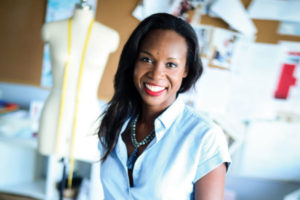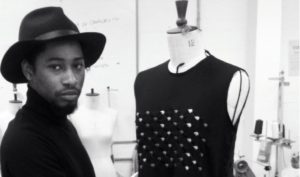Art of Fashion, a new National Gallery (NGCI) exhibition features collections by Caymanian fashion designers Isy Obi and Jawara Alleyne is currently on show until 28 November. Our curatorial team recently had an opportunity to chat with Isy and Jawara about what inspires them, their creative processes, and advice they would give to young designers just starting out and aspiring to make it in the fashion industry.
NGCI: First, let’s talk about your introduction to the Art of Fashion exhibition. Tell us a bit about when you were first introduced to the exhibition concept?
Isy Obi: We were all on a creative buzz at Carifesta in Barbados last August. Natalie Urquhart, Director of the National Gallery, was also at Carifesta, representing the work of several Cayman artists and to give a lecture about the history of art in Cayman, which Jawara and I were both honored to attend. It was inspiring to be surrounded by some of the most creative minds in the Caribbean, and when Natalie suggested the idea for this exhibition concept: a collaboration between us as designers and the National Gallery, I was excited about this opportunity to create in a way that I had never tried before.
Jawara Alleyne: I was very humbled to be asked to be a part of the exhibition when Natalie suggested the concept at Carifesta – and it came at the perfect time, as I’m at a place to start showing my work again in my community. I think the concept of this exhibition is so important and imperative to the development of not only fashion, but creativity and culture within the Cayman Islands.
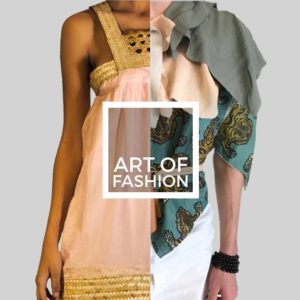
NGCI: You have spent the last 5 months creating your new fashion collection that is directly influenced from artworks found in the National Art Collection. Tell us about some of the artworks you chose to engage with and what most attracted you to the artworks you chose from the National Art Collection?
IO: There is a huge collection of work in the National Art Collection; however, choosing the art work turned out to be less daunting than I initially thought it would be. I chose pieces that drew me in visually, and where I felt I could contribute to the narrative already created by the artist. I wanted to continue that narrative but expressed from my own point of view.
JA: There are a lot of things that attracted me in the works, as there’s such a breadth of art located there [NGCI]. It was hard narrowing down what I was going to take forward for my collection but there were some things that really stood out about the works. One was the importance and the use of color. From looking into the works, I found that the artists all had a strong relationship to color. The way in which the works were created also stood out. There are a lot of abstract works that alludes to something concrete. Pinpointing specific moments in Cayman’s history that sometimes brought back memories. The collection is called Son’s of Son’s: Metaphors of Freedom and as the name suggests, the collection takes form as a metaphor of freedom and really that’s what connected me to all the works.
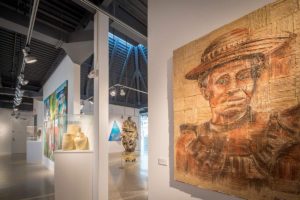
NGCI: Describe your creative process. How do you get unstuck creatively? What kind of questions do you ask before beginning a design project? Which piece of information is of utmost value?
IO: My creative “process” is a combination of intuition and intellect. They feed each other as long as I can remain balanced between the two. Intuitively, I literally dream many of my pieces, I sleep with pencil and paper beside my bed, so I can sketch out what I have seen when sleeping or meditating. I get a flash of inspiration and suddenly I know what the piece looks like. From the initial idea, intellect kicks in to work out how to translate the idea into form and continue to develop it further. I do a lot of internet and book research, produce doodles, sketches and spider diagrams, as well as take research trips for inspiration. The Victoria & Albert Museum in London, for example, provided some fantastic historical context for Spilt Milk and Ascension. My mum came along with me to have a closer look at the collections of paper dresses from the 1960s and ecclesiastical garments. The Armani Silo in Milan, and the Azzedine Alaia exhibition in London this Spring, were also great sources of inspiration.
The best way for me to get unstuck creatively is to leave whatever I’m doing and go and do something else…not always easy to do in the moment when my brain wants to keep pushing, but I’ve learnt that force has the opposite effect on creativity.
At the start of any design project, the most important question to keep asking myself is; “What am I trying to say or achieve? What is the feeling?” This keeps the core of the project focused, so that even when a project begins to develop in unexpected directions, I can allow myself to just go with the flow with confidence.
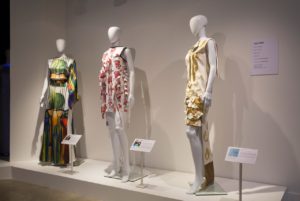
JA: For every project I do, I approach it differently. I’m currently working in a space of my own creative approach, which forces me to attach a purpose to everything I do in fashion.
For this collection I started by looking at all the works in the gallery. I wanted to find a synergy and a link between all the works there. My work in general looks a lot at creating links and bridging gaps between things thought of as unrelated. What really connected everything to me was the idea of freedom. I found that with every piece and with all the artists, the idea and concept of freedom came through, whether in the actual work itself or the way the work was created, or the reasons for creating the work. Freedom was very pertinent.
After taking some time to digest this, it was time to select specific elements that I wanted to start working with. I began to create a vague image of what the collection wants to be with all the ingredients at hand.
After defining the elements I wanted to use, I took a step away from the artist and began working with my own hands, using the same processes but allowing my own intuition to influence and take the collection forward. Developing the work by using my feelings around freedom to move forward.
I began draping and working through the collection and it became very clear that the collection for me was a huge painting. The colors, textures and way of working, ways of draping which is akin to creating paintings with fabrics. At this point my perspective as an artist started coming through.
After defining the base styles of the collection, I began working on the prints. I wanted to create something that was very close to me, so I decided to use my own paintings and work from there, digitizing this and creating a vivid digital print on silk.
Then the rest was just about working through these ideas of freedom. Revisiting my initial starting points then stepping away and coming back and stepping away. It takes a lot of time to really work through the feelings you’re trying to express in fashion. Particularly because fashion is not just art. It’s about designing and creating using both artistic focus and a strategic approach. I had to then decide physically, what the collection needed to consist of. Using deductive reasoning, strategy and where I need to go next to fill in the gaps of what’s missing in the collection.
For me, I rarely ever experience a creative block. Not now anyway, because I’ve figured out ways to work around my defects. Self-reflection is important. Understanding what your weaknesses are is so important to continuing a creative journey. There are many things I do that helps me to not get stuck, particularly because I’m not just a fashion designer but I’m so much more than that. I’m a designer, an artist, an entrepreneur, and a researcher. I’m working on so many different things that if I’m stuck in one space, I just move to another and work on something else.
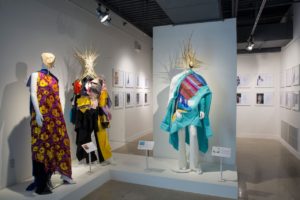
NGCI: Have you learned any new art methods or crafting methods from making your new collection? Tell us about anything unusual you have had to learn to create your new work. And how do you think these methods will affect your fashion practice going forward?
IO: I did so many things for the first time. When I conceived each piece initially I wasn’t sure how I was going to do it. For example, for the Changeling Gown, I envisaged spray-painting layers and layers of tulle to achieve the contrast of lightness and depth that I wanted in the ball skirt. This was something I had never done before and wasn’t sure would work, but John at Martlett allowed me to experiment in his spray-painting booth. For All in One Basket, when I approached Miss Eileen at the market to explain the idea and elicit her help with expertise in working with thatch, she clearly thought I was crazy but happily she went with it and we had the most amazingly creative time working together on the dress at her stall in the middle of the Saturday farmers’ market, much to the fascination of the other stall holders and curious market visitors.
Experimenting in this way was an opportunity for me to blend the conventional and unconventional when it came to construction methods, materials usage, colours and texture. I’m definitely excited about applying this experience to my future commercial work.
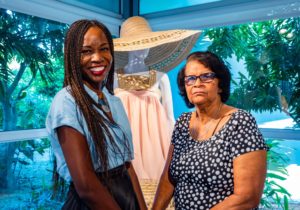
JA: Absolutely. I’m still in the stages of learning things. I love to learn, and fashion allows me to keep learning. With this collection I’ve been able to actualize so much of what I’ve learned over the past few years and through doing this you learn even more things. You can really only learn through doing.
With this collection I’m working with a lot of techniques outside of just pattern cutting and stitching. I’m working on prints, embroidery, draping, painting onto garments, painting with fabrics. There’s a lot of different processes that have gone into this collection.
With all the projects I do I try to make sure that there’s a way to get from point A to point B. I see very clearly how a specific opportunity can get me to the next steps of where I need to go, and I work very hard to ensure that I cross that bridge.

NGCI: Could you give us some insight into the format of your new collection? What are some of the things you are making? Are they menswear, womenswear, accessories, or outerwear? Give us some hints. What can we expect to see in The Art of Fashion exhibition?
IO: The format of the collection tells the story of the development of art in Cayman through a 14-piece womenswear collection.
I structured the collection by creating 4 groups or periods which set the general mood of the art works in each period. I then selected the pieces that resonated most with me within those 4 periods. Each design is my specific response to each piece, and a further development of the story that each artist is telling from my perspective. It’s a design story, within a story, within a story. I want each piece to provide a multi-dimensional experience.
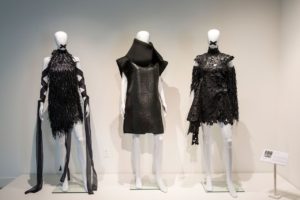
JA: Well my collections are at the boundaries of gender and identity studies. You’ll see menswear, you’ll see womenswear, and you’ll see prints, you’ll see paintings. You’ll be invited to dig deeper into the concept and context of my work and it for sure will force you to engage not only with your eyes but also with your sense of curiosity and sense of deduction and reasoning. This exhibition will be a (re)introduction to the feeling of my brand and what I stand for.
I’m also working on a small series of products which I’m hoping for the first time will be available for purchase to the Cayman Islands community. I think there’s a lot to see and you really won’t want to miss the exhibition and everything that will follow for the duration of the show.
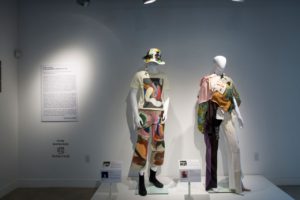
NGCI: There’s so much pressure for designers to come out with their greatest collection season after season. What advice would you give to young designers just starting out and hoping to make it in the industry?
IO: Get as much work experience as you can in whatever way you can, whether through internships, mentorship or part time work. The fashion industry is complex and there are many parts to it. Most people only ever see the glamorous end result of the world of fashion, but to get true insight into how the industry works you have to position yourself right in it. You have to be prepared to learn quickly, as you never stop learning; all my mentors and teachers are my heroes.
JA: As a designer it’s so important to find your own voice, to find your own story. To find out what it is you’re really trying to say and to say it. I think as a designer if you don’t have anything to say, anything to add, then it’s really pointless to do design, because there’s so much of the same already.
The next thing I would like to say to young designers wanting to make it in the industry and artist in Cayman in general is to be ready for the hard work that comes with it. Being in the creative industry is not easy. It comes with a lot of sleepless nights, hard work, dedication, and a lot a lot a lot of time. Time building your work, progressing from stage to stage. Working things out, trialing, testing. It takes a lot of your soul and you have to be ready for that. Ready to give up your free time.
One more piece of advice I would like to add is that you really have to listen to your own intuition. While it’s important to understand what’s going on in your creative space, and to take advice from others, it’s equally as important to work towards figuring out what your stance on matters are. No decision should be made for you and you have to be subjective. If you have a creative vision, it’s imperative for you to work towards communicating that vision. But before you can communicate it’s important to learn everything there is to learn within your field. I’m always reminded of a lesson I learnt my English teacher at John Gray High School, “before you break the rules you first have to learn the rules”, and this applies across all creative fields.
And I’d like to add some advice to parents as well, please don’t be scared to get your child involved in creative ventures and activities. Regardless of whether or not they go on to become artists, there’s so much you can learn from being creative and given the state of our culture and society we can only stand to gain from creating thinking of our own.
Things such as an awareness of self, focus, dedication, passion, drive. It teaches you to not rely on others but to create opportunities for yourself and further gives you a platform to create opportunities for others.
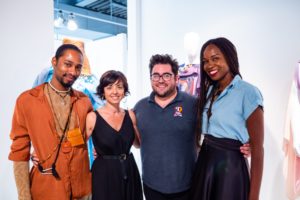
This exhibition is made possible due to the generous support of Butterfield.
